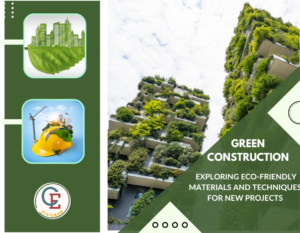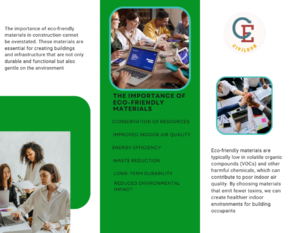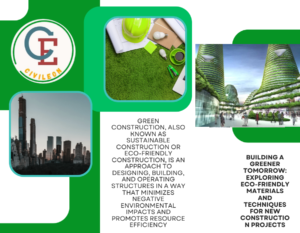In the world of construction, where towering buildings and sprawling infrastructure shape our cities, there’s a growing awareness of the environmental impact of our projects. As a civil engineer passionate about sustainable development and Green Construction , I believe it’s crucial to explore eco-friendly materials and techniques for new construction projects. In this blog post, we are going to uncover innovative solutions that not only reduce our carbon footprint but also create healthier and more sustainable environments for generations to come.
We’ll talk about using materials and techniques that are friendly to the environment. So, if you’re curious about how we can make new buildings and projects without hurting the Earth, you’re in the right place. Let’s dive in and discover the exciting world of eco-friendly construction together!
Picture this: a world where every building, every road, every structure we create doesn’t harm the planet but instead helps it thrive. That’s the vision of green construction. In this blog, we’re embarking on a journey to explore how we can build in harmony with nature.
Green Construction
Green construction, also known as sustainable construction or eco-friendly construction, is an approach to designing, building, and operating structures in a way that minimizes negative environmental impacts and promotes resource efficiency. It involves using materials and techniques that are environmentally friendly, reducing energy consumption, minimizing waste generation, and enhancing the overall sustainability of buildings and infrastructure. The goal of green construction is to create structures that are not only functional and durable but also contribute to the well-being of the planet and its inhabitants. This includes considering factors such as site selection, materials sourcing, energy efficiency, water conservation, indoor air quality, and waste management throughout the entire lifecycle of a project. Ultimately, green construction seeks to balance the needs of present and future generations while mitigating the environmental footprint of human activities in the built environment.
The Importance of Eco-Friendly Materials
The importance of eco-friendly materials in construction cannot be overstated. These materials are essential for creating buildings and infrastructure that are not only durable and functional but also gentle on the environment. Here’s why eco-friendly materials matter:
Reduced Environmental Impact: Eco-friendly materials are sourced, manufactured, and used in a way that minimizes harm to the environment. They often have lower carbon footprints, require fewer natural resources, and produce less pollution compared to traditional materials.
Conservation of Resources: Many eco-friendly materials are renewable or recycled, meaning they can be replenished or reused without depleting finite resources. By using these materials, we can reduce the demand for virgin resources and mitigate the environmental damage caused by resource extraction.
Improved Indoor Air Quality: Eco-friendly materials are typically low in volatile organic compounds (VOCs) and other harmful chemicals, which can contribute to poor indoor air quality. By choosing materials that emit fewer toxins, we can create healthier indoor environments for building occupants.
Energy Efficiency: Some eco-friendly materials offer superior thermal insulation properties, helping to reduce heating and cooling loads in buildings. By improving energy efficiency, these materials can lower energy consumption, decrease greenhouse gas emissions, and contribute to a more sustainable built environment.
Waste Reduction: Eco-friendly materials often generate less waste during manufacturing and construction processes. Additionally, many of these materials are recyclable or biodegradable, making them easier to dispose of responsibly at the end of their lifecycle.
Long-Term Durability: Many eco-friendly materials are known for their durability and longevity, which can contribute to the resilience of buildings and infrastructure over time. By choosing materials that require less frequent replacement or maintenance, we can reduce the environmental impact associated with ongoing repairs and renovations.
Here are some common eco-friendly materials used in construction:
Recycled Materials: Recycled steel, concrete, and glass can be used in construction projects, reducing the need for new raw materials and diverting waste from landfills.
Sustainable Wood: Timber from responsibly managed forests, certified by organizations like the Forest Stewardship Council (FSC), is a renewable and eco-friendly building material.
Bamboo: Bamboo is a rapidly renewable resource that can be used for various construction purposes, including flooring, structural elements, and decorative features.
Earth Materials: Materials like adobe, rammed earth, and clay can be sourced locally, reducing transportation emissions and promoting a connection to the natural environment.
Insulation: Natural insulation materials such as wool, cork, and recycled denim offer thermal performance while minimizing the use of synthetic chemicals.
Innovative Techniques for Sustainable Construction
In addition to using eco-friendly materials, sustainable construction involves adopting innovative techniques that minimize energy consumption, reduce waste, and enhance the overall efficiency of buildings and infrastructure. Here are some examples:
Passive Design Strategies: Passive design techniques leverage the natural elements—sunlight, wind, and shade—to regulate temperature, maximize daylight, and reduce the need for mechanical heating and cooling systems.
Energy-Efficient Systems: Installing energy-efficient HVAC (heating, ventilation, and air conditioning) systems, LED lighting, and smart building controls can significantly reduce energy consumption and operational costs.
Green Roofs and Walls: Green roofs and walls utilize vegetation to provide insulation, improve air quality, and mitigate the urban heat island effect, thereby reducing the energy demand for heating and cooling.
Rainwater Harvesting: Collecting and storing rainwater for non-potable uses such as irrigation, toilet flushing, and landscape maintenance can conserve freshwater resources and reduce reliance on municipal water supplies.
Modular Construction: Prefabricating building components off-site and assembling them on-site not only reduces construction time and costs but also minimizes material waste and disruption to the surrounding environment.
Interior design decor items using green construction
Certainly! Here are some interior design decor items that can be used in green construction projects:
Recycled Furniture: Choose furniture made from recycled materials such as reclaimed wood, recycled metal, or repurposed plastic. These pieces not only reduce waste but also add character and charm to interior spaces.
Sustainable Flooring: Opt for flooring materials that are eco-friendly, such as bamboo, cork, reclaimed wood, or recycled rubber. These options are durable, renewable, and contribute to a healthier indoor environment.
Energy-Efficient Lighting: Install energy-efficient lighting fixtures, such as LED bulbs or compact fluorescent lamps (CFLs), which consume less energy and last longer than traditional incandescent bulbs. Consider incorporating natural daylighting strategies to reduce reliance on artificial lighting during the day.
Low-VOC Paints and Finishes: Choose paints, stains, and finishes that are low in volatile organic compounds (VOCs) to minimize indoor air pollution and promote better indoor air quality. Look for products labeled as “low-VOC” or “zero-VOC” to ensure they meet eco-friendly standards.
Indoor Plants: Integrate indoor plants into your interior design to improve air quality, reduce stress, and enhance the overall aesthetics of the space. Select low-maintenance plants that thrive indoors and require minimal watering and care.
Upcycled Decor: Get creative with upcycled decor items made from repurposed materials, such as pallet wood shelves, vintage glass jars turned into vases, or old textiles transformed into decorative pillows. Upcycling not only reduces waste but also adds unique and personalized touches to your interior design.
Natural Fiber Textiles: Choose textiles made from natural fibers like organic cotton, hemp, linen, or wool, which are biodegradable and have lower environmental impacts compared to synthetic materials. Look for certifications such as Global Organic Textile Standard (GOTS) or OEKO-TEX Standard 100 to ensure the sustainability and safety of the fabrics.
Water-Saving Fixtures: Install water-saving fixtures in kitchens and bathrooms, such as low-flow faucets, showerheads, and toilets, to conserve water and reduce utility costs. Consider incorporating greywater recycling systems to reuse water from sinks and showers for irrigation purposes.
Reclaimed Architectural Salvage: Incorporate architectural salvage items, such as vintage doors, windows, or hardware, into your interior design to add character and history to the space. Salvaged materials not only reduce the demand for new resources but also contribute to the preservation of cultural heritage.
Energy-Efficient Appliances: Choose energy-efficient appliances with high Energy Star ratings for your kitchen and laundry room to reduce energy consumption and lower utility bills. Look for appliances that are designed for durability and easy maintenance to minimize environmental impact over their lifespan.
Feel free to follow us there on Instagram and drop a comment to say hello!



